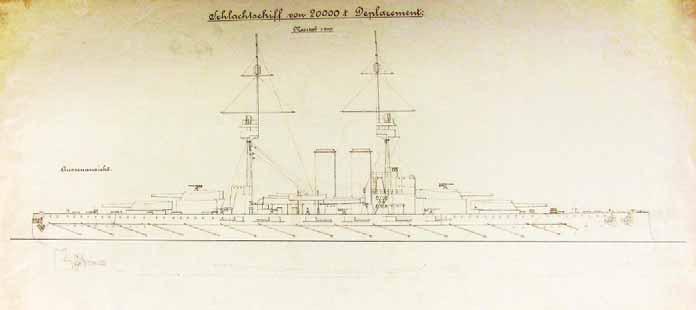commander in chief of the Anglo-French forces in the Mediterranean was Lapeyrère, in the Adriatic Sea all the French and British commanders were subordinated to the Italian commander in chief. The commander in chief of the Italian Navy between 1914 and 1917 was Prince Luigi Amedeo Duca degli Abruzzi, a polar explorer and the cousin of King Vittorio Emanuele III. Oddly enough, the three parties had not any specific operational plan when Italy declared war on Austria-Hungary. This, and other factors, as the far from cordial Franco-Italian relationship or the low opinion of the British on the Italian Navy at least questioned the efficiency of the future naval cooperation between the three powers. In May 1915 the Italian Navy had five completed dreadnoughts (Dante Alighieri, Giulio Cesare, Leonardo da Vinci, Conte di Cavour and Caio Duilio) and one still under construction, completed in March 1916 (Andrea Doria). This was an equal, or slightly superior force compared to the three Radetzkys and the three completed Tegetthoff s, while in older battleships, armored cruisers, cruisers and smaller units the First Allied Fleet had at least a twofold superiority over the Austro-Hungarian fleet. The Italian dreadnoughts were based at Taranto, while the four Regina Elena class and the two Regina Margherita class standard battleships, the newest Italian ships of this type were deployed at Brindisi. Abruzzi planned to keep his dreadnoughts outside the Adriatic in the first phase of the war. Nevertheless, he as many others in the Italian fleet dreamed of the revenge for Lissa, but Abruzzi together with Thaon di Revel was cautious enough. Only after the southern Adriatic was cleaned of Austro-Hungarian light surface units and submarines would leave the Italian battle fleet Taranto for the Southern Adriatic in hope that Haus and the Austro-Hungarian fleet could be lured out from Pola. But the advantageous moment never came and the Italian dreadnoughts did not enter into the Adriatic until October 1918. Political and military leaders of the AustroHungarian Monarchy were well aware of the diplomatic activity between the Triple Entente and Italy. On 27 April, the AOK warned Haus that Italy might launch an attack without declaring war. But Haus was well aware of the situation even without this warning as he regularly read the reports of the naval intelligence service as well as the Italian
press. In accordance with the Treaty of London, on 4 May Italy officially left the Triple Alliance, so it became evident that the hostilities would soon begin between the Monarchy and Italy. Korvettenkapitän Albrecht Freiherr von Freyberg, the German naval attaché in Vienna and a great enemy of Haus since August 1914, urged the Austro-Hungarian Navy to strike first, even before a formal declaration of war. The Marinesektion told him that no attack could be launched without the authorization of the Emperor.451 Haus had plans from August 1914 for a strike against Ancona and the eastern coastline of Italy to be executed immediately after the Italian declaration of war. From 19 May the cruisers Helgoland and Admiral Spaun and several destroyers patrolled the routes between Gargano, Lagosta and Pelagosa, watching the lower Adriatic to prevent any unpleasant surprise from the south. The waters before Ancona were searched twice by torpedo boats and submarines to make sure that the Italians had not laid mines there. When word of the Italian mobilization ordered on 22 May reached Pola, the fleet was ready for an action against Ancona. It seemed probable that Italy would declare war on Austria-Hungary on the next day, so on 23 May the fleet in Pola stood ready to put to sea after darkness fell.452 The Bombardment of Ancona At 4:15 a.m. on 24 May Peter von Moritz, the Austro-Hungarian Consul General in Ancona was tipped out of bed by two violent detonations which were followed by thundering of guns. At 5 a.m. an Italian police officer angrily told him: “Your nation is bombarding an open city!” Later he learned from another police officer that seventeen Austro-Hungarian warships had appeared before the city and had bombarded it.453 The Bombardment of Ancona on 24 May was the largest action of the Austro-Hungarian Navy during the war. This was also the only successful large fleet action against the enemy, and the only occasion – not counting the failed rendezvous with the Goeben in August 1914 – when the units of the Tegetthoff and the Radetzky classes put to sea together against the enemy. The detailed orders for the strike against Ancona and the Italian coastline were issued on 9 May.454 Haus as Flottenkomman-
— 131 —






























